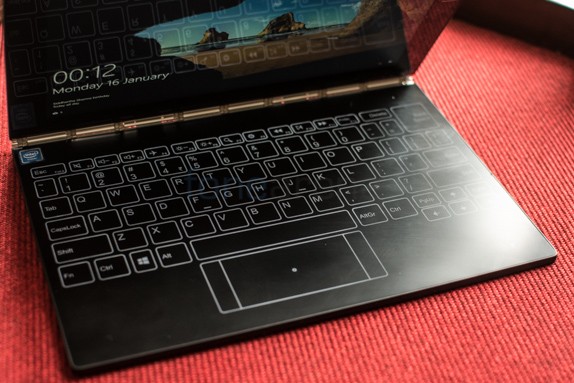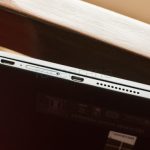
Working in the technology industry, we often get a chance to try out bleeding edge tech. While a lot of this tends to be centred around smartphones, traditional PCs too have seen the benefits. From the near bezel-less Dell XPS series to the Touch Bar equipped Macbook Pro and now the Yoga Book which gets rid of a traditional keyboard for a layout that is both extraordinary to look at and surprisingly functional too.
Lenovo Yoga Book specifications
- 10.1-inch (1920 x 1200 pixels) FHD display, 400 nits brightness
- Intel Atom x5-Z8550 Processor (2M Cache, Quad-Core, Up to 2.4 GHz)
- 4GB LPDDR3 RAM, 64GB internal storage, expandable memory up to 128GB with microSD
- Android 6.0 / Windows 10 Pro
- Single nano SIM
- 8MP Auto-Focus rear camera
- 2MP Fixed-Focus camera
- Dolby Atmos
- 4G LTE, WiFi 802.11 ac (2.4 GHz and 5 GHz), Bluetooth 4.0
- Dimensions: 256.6 x 170.8 x 9.6mm; Weight: 690g
- 8500 mAh battery
The Yoga line up of devices have seen a fair number of models that integrate some form of 2-in-1 capability. On that front, the Yoga Book isn’t quite extraordinary. The path breaking feature is the newfangled input paradigm but for the moment, let’s keep the keyboard aside and look at this machine for what it is.

The Lenovo Yoga Book is an incredibly small machine. Caught unaware, the device could easily pass off as a journal kept on a table. The matte black shell, ultra slim form factor and not too large size given the 10.1 inch display, the Yoga Book is minimalist in nature and as good-looking as Windows powered machines come.

Over along the spine lies the watchband like hinge that Lenovo has been talking about going back to the Yoga 3 Pro from 2014. The watchband allows for almost infinite positioning options. On the flip side, they can cut into your palm if you hold the Yoga Book from the side. We don’t expect this to be a problem for most users though.
Moving on, let’s talk about the port selection. The left side is where you’ll observe the microUSB port that is also used for charging up the machine. Alongside is a micro HDMI connector for video out as well as a tray cut out that has a microSD slot in addition to a SIM card tray. The other side of the machine has the 3.5mm audio jack. There’s also a volume rocker and power button. The port situation as you can see is rather abysmal and the lack of a USB Type C connector just doesn’t make sense. What this means is that you’ll not only need a USB OTG connector to attach any external storage to the device but you also won’t be able to charge up the device alongside. Given the plethora of USB C based docks on their way for Apple’s Macbooks, the lack of compatibility makes the Yoga Book much worse than even the Macbook from a connectivity perspective.

Open the lid up and you’ll note the 10.1 inch Full HD panel capable of 400 nits of brightness. The 16:10 panel is bright, vibrant and viewing multimedia is an enjoyable though cramped experience. The touchscreen display panel sits in the middle of very wide bezels that detracts from the experience. The only justification for such wide bezels would be to use them as a place to rest your wrist while working with the stylus on the screen but we feel that Lenovo could have easily increased portability by a significant degree by opting for slimmer bezels. A 2MP camera sits along the top edge of the screen. For what it’s worth, an 8MP camera sits on the keyboard edge that can be used when the keyboard is flipped over in tablet mode but really, just use your smartphone to take photos.

The most amazing or rather interesting aspect of the Yoga Book has to be the keyboard. But wait.. earlier on in the review we’d mentioned that the Yoga Book does not have a keyboard. What it does have however is a flat touch surface that lights up in an insanely cool Tron like fashion to create a more or less full size keyboard. Called the ‘Create Pad’, The touch surface works exactly like a keyboard and has haptic feedback to simulate key press feedback but of course, there’s really no comparison here.

Typing, for the first few days, is an exercise in frustration. It does get better but a week down the line, we’re still nowhere close to full speed. Since the surface is a capacitive layer, you’ll want to avoid placing your palms on it while typing. This alone requires you to readjust your typing pace. Jabbing at the keyboard display works but isn’t very comfortable while typing long form articles. The miniature trackpad below the keys however is particularly bad and more often than not, it would just be easier to tap the screen.

You can tap a small illuminated pencil key to turn off the ‘Halo Keyboard’ and convert the surface into a blank slate that doubles up as a graphics tablet. In this mode, the surface is capable of recognizing up to 2048 levels of pressure which can be put to good use if you have any artistic sensibilities. Now, we’ve seen pressure sensitivity built into tablet displays before so while it is really nice to have, it isn’t quite a brand new feature. What is new however is a feature unique to the Yoga Book. Lenovo’s bundled in Real Pen let’s you replace the capacitive stylus for a ballpoint refill. Place a sheet of paper on top of the Create Pad surface, start writing your notes and watch them get instantly digitised and added to OneNote or any other system you might use. The Yoga Book comes bundled in with a fair few sheets of paper but you’re not dependent on Lenovo for this and can replace it with any regular sheet of paper and a backing board. Just be a bit careful without how much pressure you put on the surface as it does have a tendency to pick up scuffs.

Let’s talk performance. The Yoga Book is optimised for battery life and creative use which essentially means gaming is out of the window but what about applications like Photoshop? You’d be surprised to note that despite being powered by an Intel Atom x5-Z8550 processor which by all means is an entry-level chipset, the shape shifting device manages admirably well. Being a ultraportable, the 2-in-1 has a fanless design which can lead to a bit of thermal throttling on extended heavy use of the CPU.The 4GB of RAM on the system is nothing extraordinary but does the task. If you’re the kind of person who has a dozen tabs open in Chrome while working on Photoshop and playing music too, this will prove to be pretty limiting. For everyone else, you should be okay but for a relatively high-priced machine, we’d expect the Yoga Book to ship with at least 8GB of RAM. Photoshop takes a while to get started but beyond that, as long as you don’t go too crazy with the layers, it can manage the task. Video editing however is definitely out of the picture. We took the example of Photoshop because of the presence of Wacom grade hardware but note taking too is another typical use case scenario with Lenovo bundling in their Real Pen Stylus as well.

Storage is very limited at 64GB however you can use the recessed microSD card slot to bump it up. There’s of course WiFi, Bluetooth as well as LTE support via the SIM card slot. The 8,500 mAh battery is rated for 13 hours of use but that is of course only in an ideal scenario. On an average we managed between 7-8 hours of mixed use with pure video viewing resulting in battery life of a little over 10 hours. Not bad but well lower than the claims made by Lenovo.

As a first generation product, the Lenovo Yoga Book brings with it a lot of promise. Think of it like a concept car that pushes the boundaries of technology and makes you think what if there’s a better way to do this. In its current form, it is really hard to recommend the Yoga Book as your primary laptop mostly because of the huge learning curve and speed drop on the capacitive keyboard but also because the specifications really leave you wanting for more power. Believe us though, we’ll be waiting eagerly to see where Lenovo takes this concept with the next generation Yoga Book. The Lenovo Yoga Book is priced at Rs. 49990 and is available exclusively on Flipkart.


